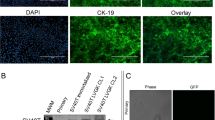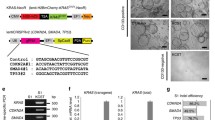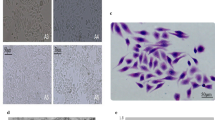Summary
To investigate characteristics of pancreatic carcinoma growth behavior, the cloned cell lines, HPD1NR, HPD2NR, and HPD3NR, were established from a transplantable hamster ductal adenocarcinoma induced byN-nitrosobis(2-hydroxypropyl)amine (BHP). All three clones showed similar epithelial cell morphology and grew as sheets in culture with no differences in doubling times, ranging from 23-28 h. Mutation in the c-Ki-ras exon 1 was detected in common. The modal chromosome numbers were also found to be similar at 60, 62, and 60-62 in the less than tetraploid cells in the three clones. In contrast, a clear difference in frequencies of tetraploid or polyploid cells at 24.7, 22.5, and 75.5% in HPD1NR, HPD2NR, and HPD3NR, respectively, was evident. Tumorigenic potency evaluated by transplanting individual clones revealed HPD3NR to display pronouncedly less growth in syngeneic hamsters. The results suggest that increase in frequency of tetraploid or polyploid cells might be associated with a decreased in vivo growth potential of hamster pancreatic ductal adenocarcinomas, and suggest that these clones might become a valuable tool for understanding in vivo growth mechanisms of cancer cells.
Similar content being viewed by others
Abbreviations
- EDTA:
-
ethylenediaminetetraacetic acid disodium salt
- BOP:
-
N-nitrosobis(2-oxopropyl)amine
References
Knapp ML. Partial characterization of an oncofetal antigen: Its role in the differential diagnosis and therapy of patients with pancreatic cancer.Ann Clin Biochem 1981; 18: 131–143.
Health and welfare statistics in Japan. Health and welfare statistics association. 1992.
Pour P, Krueger FW, Althoff J, Cardesa A, Mohr U. Cancer of the pancreas induced in the Syrian golden hamster.Am J Pathol 1974; 76: 349–358.
Pour P, Althoff J, Krueger F, Schmaehl D, Mohr U. Induction of pancreatic neoplasms by 2,2′-dioxopropyl-N propylnitrosamine.Cancer Lett 1975; 1: 3–6.
Pour PM, Runge RG, Birt D, Gingell R, Lawson T, Nagel D, Wallcave L, Salmasi SZ. Current knowledge of pancreatic carcinogenesis in the hamster and its relevance to human cancer.Cancer 1981; 47: 1573–1587.
Pour PM. Cell differentiation during pancreatic carcinogenesis.Scand J Gastroenterol 1988; 151: 123–130.
Fujii H, Egami H, Chaney W, Pour P, Pelling J. Pancreatic ductal adenocarcinomas induced in Syrian hamsters byN- nitrosobis(2-oxopropyl)amine contain a c-Ki-ras oncogene with a point-mutated codon 12.Mol Carcinogenesis 1990; 3:296–301.
Tsutsumi M, Murakami Y, Kondoh S Tsujiuchi T, Hohnoki K, Horiguchi K, Noguchi O, Kobayashi E, Okita S, Sekiya T, Konishi Y. Comparison of K-ras oncogene activation in pancreatic duct carcinomas and cholangiocarcinomas induced in hamsters byN-nitrosobis(2-hydroxypropyl) amine.Jpn J Cancer Res 1993; 84: 956–960.
Tsutsumi M, Kondoh S, Noguchi O, Horiguchi K, Kobayashi E, Okita S, Ohashi K, Honoki K, Tsujiuchi T, Konishi Y. K-ras gene mutation in early ductal lesions induced in a rapid production model for pancreatic carcinomas in Syrian hamsters.Jpn J Cancer Res 1993; 84: 1101–1105.
Cerny WL, Mangold KA, Scarpelli DG. K-ras mutation is an early event in pancreatic duct carcinogenesis in the Syrian golden hamster.Cancer Res 1992; 52: 4507–4513.
Almoguera C, Shibata D, Forrester K, Martin J, Arnheim N, Perucho M. Most human carcinomas of the exocrine pancreas contain mutant c-K-ras genes.Cell 1988; 53: 549–554.
Smit VT, Boot AJ, Smits AM, Fleuren GJ, Cornelisse CJ, Bos JL. KRAS codon 12 mutations occur very frequently in pancreatic adenocarcinomas.Nucleic Acids Res 1988; 16: 7773–7782.
Lieber M, Mazzetta J, Walter N-R, Kaplan M, Todaro G. Establishment of a continuous tumor-cell line (PANC-1) from a human carcinoma of the exocrine pancreas.Int J Cancer 1975; 15: 741–747.
Yunis AA, Arimura GK, Russin DJ. Human pancreatic carcinoma (MIA PaCa-2) in continuous culture: Sensitivity to asparaginase.Int J Cancer 1977; 19: 128–135.
Grant AG, Duke D, Hermon-Taylor J. Establishment and characterization of primary human pancreatic carcinoma in continuous cell culture and in nude mice.Br J Cancer 1979; 39: 143–151.
Yamaguchi N, Uozumi M, Ikeuchi H, Morioka H, Machino M, Kawai K. Establishment and characterization of a carcinoembryonic antigen producing cell line derived from human pancreatic exocrine cancer.Gastroenterol Jpn 1983; 18: 585–592.
Kyriazis AP, McCombs III WB, Sandberg AA, Sloane NH, Lepera R. Establishment and characterization of human pancreatic adenocarcinoma cell line SW-1990 in tissue culture and the nude mouse.Cancer Res 1983; 43: 4393- 4401.
Akagi T, Kimoto T. Establishment and characteristics of a human pancreatic cancer cell line (HGC-25).Acta Path Jap 1977; 27: 51–58.
Metzgar RS, Gaillard MT, Levine SJ, Tuck FL, Bossen EH, Borowitz MJ. Antigens of human pancreatic adenocarcinoma cells defined by murine monoclonal antibodies.Cancer Res 1982; 42: 601–608.
Dexter DL, Matook GM, Meitner PA, Bogaars HA, Jolly GA, Turner MD, Calabresi P. Establishment and characterization of two human pancreatic cancer cell lines tumorigenic in athymic mice.Cancer Res 1982; 42: 2705–2714.
Okabe T, Yamaguchi N, Ohsawa N. Establishment and characterization of a carcinoembryonic antigen (CEA)-producing cell line from a human carcinoma of the exocrine pancreas.Cancer 1983; 51: 662–668.
Tsujiuchi T, Tsutsumi M, Denda A, Amanuma T, Kondoh S, Kamino K, Konishi Y. Effect of 3-aminobenzamide on induction of multiorgan carcinogenesis byN-nitrosobis(2- hydroxypropyl)amine in hamsters.Jpn J Cancer Res 1991; 82: 793–799.
Saito S, Nishimura N, Kubota Y, Yamazaki K, Shibuya T, Sasaki H. Establishment and characterization of a cultured cell line derived from nitrosamine-induced pancreatic ductal adenocarcinoma in Syrian golden hamsters.Gastroenterol Jpn 1988; 23: 183–194.
Egami H, Takiyama Y, Cano M, Houser WH, Pour PM. Establishment of hamster pancreatic ductal carcinoma cell line (PC-1) producing blood group-related antigens.Carcinogenesis 1989; 10: 861–869.
Liang P, Pardee AB. Differential display of eukaryotic messenger RNA by means of the poly merase chain reaction.Science 1992; 257: 967–971.
Elsasser H-P, Lehr U, Agricola B, Kern HF. Establishment and characterization of two cell lines with different grade of differentiation derived from one primary human pancreatic adenocarcinoma.Virchows Archiv B. Cell Pathol 1992; 61: 295–306.
Author information
Authors and Affiliations
Rights and permissions
About this article
Cite this article
Mori, T., Tsutsumi, M., Noguchi, O. et al. Characterization of three cloned cell lines from aN-nitrosobis(2-hydroxypropyl)amine-induced transplantable hamster pancreatic ductal adenocarcinoma. Int J Pancreatol 16, 171–177 (1994). https://doi.org/10.1007/BF02944328
Received:
Revised:
Accepted:
Issue Date:
DOI: https://doi.org/10.1007/BF02944328




